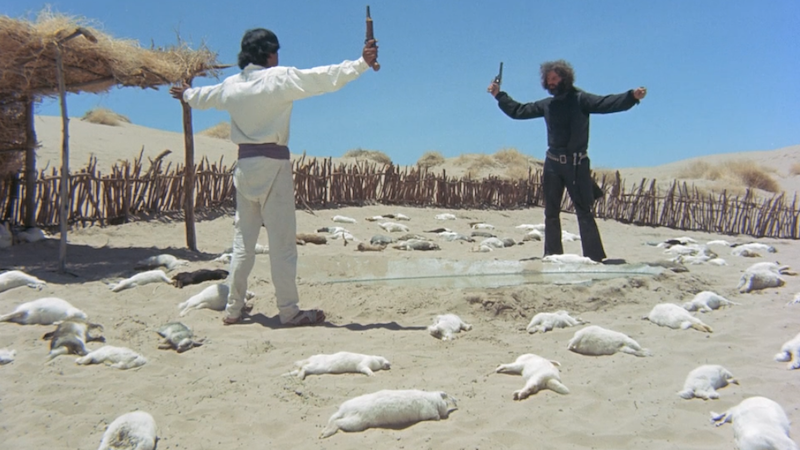The scene you’re most likely to remember comes right at the start of The Bone Breakers. Inside a warehouse, bodybuilding weights are packed into a suitcase which, once sealed, is carried up some scaffolding. Below, men hold another man’s arm so that it rests on two blocks, one at each end, then the man on the scaffolding drops the case from the scaffolding onto the man below’s rested arm, painfully breaking it. You’re immediately wondering what’s going on, possibly assuming the men are gangsters and the man whose arm has been broken has upset or crossed them in some way.
However, the man is compliant and even though his fractured arm clearly causes him considerable pain afterwards, he goes along with and and doesn’t appear to bear the men who have done this any ill will. They get him to the hospital where his arm is put in a sling, then take him to another building in which he’ll live in the short term, presumably to recuperate.
Beyond that, it isn’t entirely obvious what’s going on although, in fact, it’s very simple. Although the glowing term ‘inspried’ sounds far too optimistic and pleasant, this is inspired by an insurance scam in Palermo whereby people’s bones were broken to enable them to claim on the insurance money. Or rather, to enable to claims of the people whose bones were broken and the criminals who set up this scheme, who take their not inconsiderable cut even as they claim in good capitalist fashion to be providing a service that people want. All this (and the exact purpose of the house) is explained in a brief title at the close of the film.
To tell this horrific story, co-writer and director Vincenzo Pirrotta weaves a complex network of characters who prove really hard for the audience to keep up with. Chief among these in Vincenzo (played by Pirrotta himself) who, it quickly becomes apparent, isn’t really suited to this or any similar line of business. You need to be ruthless, make threats and be able to see them through if people using the service try to bend the rules, but Vincenzo is too likely to listen to people and try and help them.
Moreover, he’s completely smitten with black-clad drug addict Luisa (Selena Caramazza), despite his being told she is unreliable, and after having sex with her tries to help her by getting her arm broken. It’s fairly obvious that this has the potential to go bad and poison their blossoming relationship pretty fast, alongside various other broken bone situations with other people who develop all sorts of complications. Towards the end, we even get into faked, fatal road accidents.
There’s another gang member much more ruthless than Vincenzo – and therefore much more likely to get the required results – who starts taking work off him. Vincenzo’s Catholic mother (Aurore Quattrocchi), meanwhile, alongside verbalising piety, seems to know exactly what’s going on and constantly tells him what to do, even though her admonitions may be beyond his essentially compassionate nature.
In addition to its overly complicated storyline, perhaps the narrative’s problems lie in showing its hand too early. After that devastating opening, it’s difficult to imagine anything else having quite the same impact. And although the film presses several scenarios into play in the hope of achieving that end, nothing quite tops it.
Nevertheless, as these gruesome and immoral events play out, there’s a compelling fascination to them, particularly with a central character who lacks what it takes to make such things run smoothly because he possesses a basic humanity that flies in the face of what all those around him are doing or encouraging. Altogether, an incredibly bleak and depressing vision, definitely not recommended for the faint of heart, which nevertheless carries within it the seeds of optimism: things are bad, but some people are striving, even if unsuccessfully, to make them better. Or, at least, less bad.
The Bone Breakers plays in the Tallinn Black Nights Film Festival. Watch the film trailer below:









